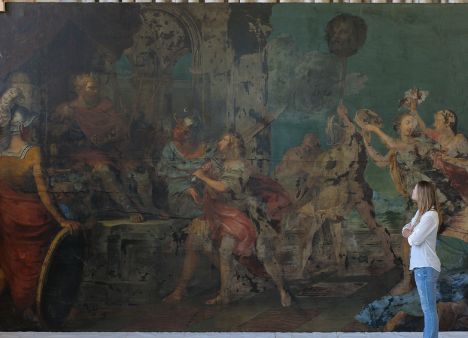Villanova’s (Not So) Hidden Treasure: The Triumph of David

david
November 12, 2019
The story of David and Goliath, beyond being a personal favorite, is incredibly common subject matter for artists in every layer of history. How inspirational. The triumph of a righteous weakling in the face of previously unconquerable evil; an original underdog story. Less depicted is the (admittedly less exciting) scene post-triumph, such as the examples seen in our very own Reading Room. Despite its implicit grandeur, the Triumph of David is not a triumph for art. After a thorough formal analysis, supplemented by input from Villanova’s own Dr. Lagalante (who headed the research and restoration of the painting), one can sheepishly admit that it is not the size that matters—it’s how one uses the canvas.
The massive 12’ by 19’ oil canvas stretches imposingly above the Old Falvey entrances to the Reading Room. The painting is hung on the wall directly across from the large windows, which—despite it fitting the space perfectly—is unfortunate. In my email correspondence with Dr. Lagalante, I asked the question echoing in every art history aficionado’s head: Why? Why place it on such an awkward, hard to see wall? He did not have an answer for my agonized heart, writing, “The restoration team didn’t have input on the placement of the painting in the room or the design of the new Reading Room by the architect.” (This interview went much more amicably now that I knew Dr. Lagalante and his team were not responsible for such abysmal actions).
I inquired, because the placement prevents a clear view of the painting from the ground—one must bob and weave between the tables in order to get a good visual, and still then crane his neck to see the upper details. The bobbing and weaving does not end with a seat on the far end of the room, however—as soon as the sun peaks out from behind the clouds, the sunlight bleeds across the canvas, creating a glare that fuzzes out the color and the details of the piece. This glare obscures sections of the painting depending on the placement of the viewer: to get an unobstructed view, the piece must be observed in segments, hopefully on a cloudy day. Weather aside, no matter where one sits in the reading room, it remains difficult to view the top portion of the painting. Details like Goliath’s head on top of the pike are difficult to see from its position high on the wall.
Upon seeing this light phenomenon, I was worried. My museum gremlin brain started panicking. “Close the blinds! The sunlight will harm the painting! It was only just restored!” To alleviate (or confirm) my fears, I again deferred to the knowledge of Dr. Lagalante. He assured me that it was not as big a deal as I imagined, “Proper room lighting, temperature and humidity control, a protective varnish, and UV absorbing glass on the windows will all help to prolong the lifetime of the painting.”
Fears assuaged about the natural light in the Reading Room, I move onto the movement of light in the piece. The source of the light in the painting is unclear. It is much brighter in the foreground—the figures closest to the viewer are illuminated clearly—but fades away in the deeper layers. The men raising Goliath’s head are much dimmer than David, for example. This is further emphasized by a dull color scheme—most of the paint is dark, implying night or an otherwise lack of sun. It is worth mentioning that the shadow increases with height as well—Goliath’s head is shrouded in shadow, and it actually took me a while to notice the King sitting on his throne due to the darkness of the picture. The light is brilliantly illustrated on the clothes of the characters: fabric glimmers with a sheen that emphasizes the body beneath the fabric, giving form and a sense of movement to the wearer. The color of the fabric is also bright when illuminated, contrasting sharply with the muted colors of the rest of piece. The metal of the armor is also well-rendered, gleaming in the light and making the helmets in particular look almost three-dimensional. However, the origin of light is still not clear in the painting.
The light also interacts with the composition of the piece. The light directs us to David’s face. He is very close to center of the painting and well-illuminated. Strangely enough, the center of the piece—the men holding Goliath’s head—is poorly illuminated. In contrast, our eye is strongly drawn to the woman with her back turned to us in the bottom right corner—she’s the brightest thing in the piece, and thus a focal point. This does not make sense from a compositional point. There is a rough triangular movement between the strong diagonal of David’s sword and the ladies’ arms flung to point to Goliath’s head, but it is not done with force enough to be considered instrumental to the piece’s composition. There is certainly a wonderful sense of movement in the piece; the robes flow around bodies tensing and stretching and reaching and striding. Other than that compositional detail, however, the piece falls flat for me. I love that Villanova has such a grand artifact, and I would love to say the Triumph of David is an exceptional win, but after sitting with it, I admit I took the L.

